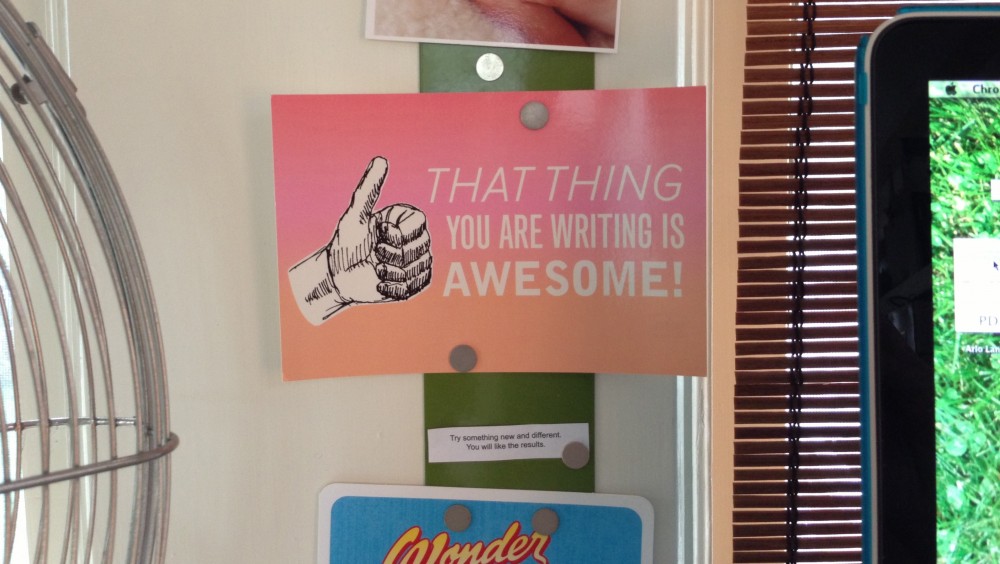Review of AIGA Design Educators Conference
“The conference was framed as a context for educators to demystify academia; clarifying teaching methods, assessment, and relevant project ideas specific to the field of graphic design. What was supposed to be a valuable, pragmatic conference turned into a rich discussion about our identity and values. Is graphic design classified as a discipline, a profession, or a pre-profession? And why does it even matter to define ourselves? Furthermore, are we properly preparing students to be researchers and makers in a world that requires cross-cultural literacy? And finally, how are we even able to accomplish it all?”
Mother’s Day: Design Educators Edition
“Marty: I wish people would talk about families more in the workplace. There still seems to be a real stigma about talking about kids or other family obligations at work or in school. We are all living lives outside of our jobs and I wish that was more celebrated. I know women have a fear of appearing less available because they are moms (yet men don’t suffer from that same paradigm–that’s a whole other conversation!), but I have never met anyone more hardworking than a working mom.”
Oppositions Attract:
Motherhood and the Tenure Track
“Having a child was the worst career move I ever made.” That is the advice that I received during my first pregnancy when asking an esteemed design educator how she balanced work and motherhood. While this response could have been in jest (still not sure!), the harsh pessimism is something much more serious and unfortunately, common. Being a working mom isn’t easy. Being a working designer mom in academia is near impossible. *Near being the key word, there’s hope — I promise! While there are substantial challenges, being a mom can also bring a lot of new skill sets and insights to your life as an academic.
Exploring Interface Possibilities with Marshmallow
We live in an incredibly complex digital world. My new iPhone can do what?! I can collaborate online with how many people at once?! Despite this exciting features-based wonderland, many designers retain a rather dogmatic approach when designing for the screen. Why do we call webpages “pages?” Why does the navigation have to be at the top of the screen? Why do we design as if the screen space was only two-dimensional when we might simulate depth?…
Go Ahead, Be Selfish. Make Your Presentation
Work For You
As designers, we are often required to make public presentations, whether as initial client pitches, as progress reports on in-process work, or as formal talks at conferences. Typically, the goal is to educate or inspire audiences, but it is important to remember that there is value to the presenter in publicly discussing and sharing work…
Exploring the Typographic Wild West
As graphic designers we have been thoroughly trained to finesse typography. We painstakingly analyze each line break, each dash, each quotation mark. We consider it a point of pride to scoff over “type crimes.” We are obsessed. With typography. In print…
Strengthen Your Design Process With Narrative
Designers often play the role of visual storytellers. We arrange visual elements creating narratives that resonate with our audiences. This ability to create narratives that capture attention and provide focus can be useful in our design process. Persona writing and scenario building are two narrative-based approaches that help designers model future use…
Reporting For Duty: Collaboration’s Biggest Fan
Collaboration doesn’t come naturally to everyone. We all have our weaknesses, but unfortunately, or fortunately if you love working together like I do, our current design practice is increasingly collaborative…
Failure: It’s Not That Bad
Failure can be defined as a lack of success. But, how does one understand success within a creative practice?…
Share Language: Design + Cartography = Wow
When cartographers make maps, they organize content according to relevancy, translate physical realities into visual representations and position elements to communicate messages. Designers appropriate these cartographic approaches and apply them to communication problems…
Convey Your Interactive Concepts
Interaction designers are not web developers and should not be expected to take on the role of development. Developers are experts in what they do, which allows us to be experts in what we do: creating the conditions for meaningful user experiences…
True Sustainability: A Way of Being
We love to do good. The design community is increasingly engaged with doing work for good and embracing do-goodery. This is manifesting is several ways: following sustainable practices, supporting communities and organizations that need assistance, raising awareness about the benefits of socially minded design, etc. In tough economic times, our well intentions may move to the back-burner as we struggle to make ends meet, but how can we continue to do good?…
Many of these essays were originally written for Parse during my time as a regular contributor. “Parse aims to make sense of issues and information relevant to design practitioners, regardless of the disciplines they work in. Parse makes big ideas useful, actionable and applicable. It distills jargon, reduces complexity, pares words, omits gobbledygook. It’s open-source, approachable and friendly. Parse is the brainchild of Jennifer and Ken Visocky O’Grady and is presented by HOW.”
postcard from 826 National
